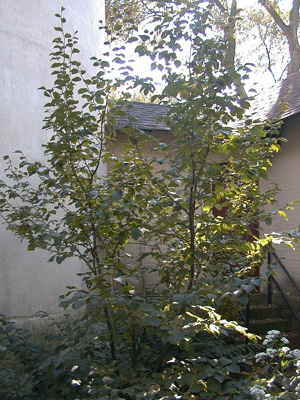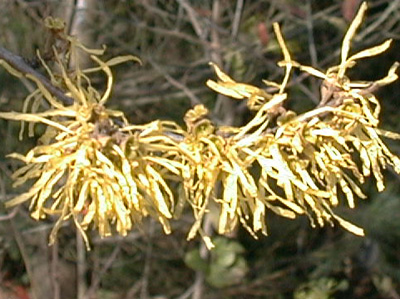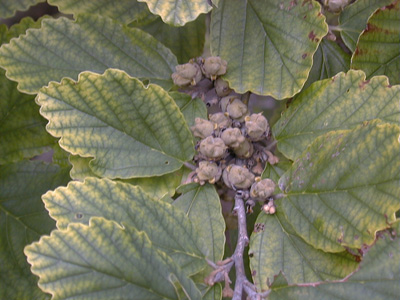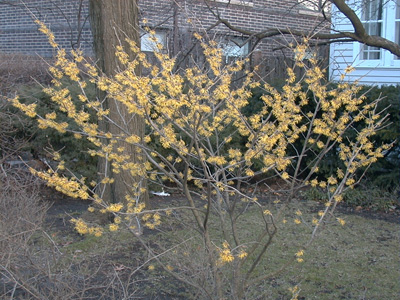
Hamamelis virginiana - Witch Hazel
Family: Hamamelidacea commonly called the witch hazel family. This is an ancient family with survivors in North American, Asia, Africa, and Australia. Some biologists have suggested that the witch hazel family is ancestral to the birch and beech families.
Genus: Hamamelis – hama = "together” and melis = “fruit”, “together with fruit” refers to the presence of seeds, flowers, and leaf buds on the branches at the same time. This genus shows the classic distribution of the ancient temperate forest species, eastern North America and eastern Asia.
Species: virginiana – from Virginia.
 |
Witch hazel planted close to the door and pathway where the fragrance can be enjoyed. |
Plant: Witch hazel is a large, spreading, aromatic shrub or small multi-stemmed tree growing ~ 20’ in ideal conditions. 6’ to 10’ is more common in garden specimens.
Bark: Smooth and thin with a grayish color.
Branches: Alternate, zig-zag, dense growth in Sun, loosely layered growth in shade.
Leaf: ~5” long and ~3” wide, obovate, wavy-edged, green on top, pale underneath, turning yellow in Autumn, hairy leaf buds

Flower: 1.5”, yellow, ribbon-like petals. Flowers remain rolled tight during inclement or extremely cold temperatures, and open on sunnier days. 4 sepals, 4 petals, 4 stamens, 4 nectar-bearing staminodes, 2 celled superior ovary, 2 styles. The nectar in the flower glistens on a sunny day. Cold hardy insects (bumblebees, flies, midges) pollinate witch hazels. The sweet clean fragrance travels well on a brisk breeze.

Fruit/Seed: small, less than an inch long, capsule with four small lobes. Lobes split to reveal 2 shiny, black, oblong, pointed seeds. The walls of the capsule slowly contract until the seeds are expelled with force.
Root: Thick, dark, and cordlike with extensive fibrous roots near the tips. New shoots sprout from the crown. It is common to find new shoots springing up beside old dying stems.
Origin: Hamamelis virginiana is native to the woods of the eastern North America from Nova Scotia and Wisconsin to Florida and Texas. This is the hardiest genus and the only one to bloom in Autumn.
Related Species: H. vernalis from the Ozarks along with H. mollis from China and H. japonicus from Japan are all late Winter-early Spring blooming shrubs. There are many Spring blooming cultivars available in varying shades of yellow, orange, and red. The bright yellow Arnold Promise is a spectacular performer.
